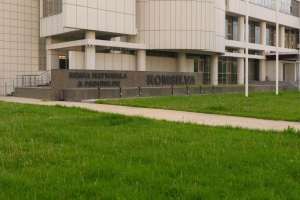Artificial Intelligence and innovative technologies are the means by which energy efficiency targets can be reached and by which the ESG concept can be implemented in real estate, both in the area of residential buildings and in the area of buildings in the logistics or industrial sector, they said yesterday participants in the fourth edition of "Smart Building and Innovation in Real Estate", an event organized by BusinessMark and EnergyPal, in Bucharest.
At the opening of the event, Lucian Anghel - founder and CEO of EnergyPal and Facilities Management Services - stated that, in addition to the buildings built before 1990 and even in the first decade after the Revolution of December 1989, they are no longer energy efficient and the constructions made more than 10-15 years ago, they are not effective even from the point of view of the BMS - building management system.
Mr. Anghel also said: "The idea of energy efficiency also has a comfort component. Energy efficiency is about reducing costs, but also about increasing comfort, about increasing the state of well-being of customers, which, for example, in shopping malls also brings increased income for tenants of commercial spaces".
The founder of the EnergyPal company showed that in order to achieve energy efficiency, it is necessary to implement a smart metering system. Lucian Angel specified: "The smart metering system is the equivalent of the medical analysis or the x-ray that the doctor does for you. Through such an analysis, through which I see the consumption at any time of the day, I can see what measures I need to take later for energy efficiency. We analyze what is happening in the system, then we introduce a measurement system, after which we come up with an energy efficiency system (...) Everyone wants photovoltaic panels, but before going to this step, you have to see what you consume. You will produce more and cheaper, but you will actually lose. First, you have to do the efficiency in order to switch, then, to renewable energy".
Dan Mocanu, Vice President of Organizational Development at EnergyPal said that new technologies bring tremendous value to all stakeholders in a building - from those who design it to everyday users, and solutions must respond to the challenges presented. by all these stakeholders.
Adrian Stoica, EBRD consultant, Managing Partner Green Dot ESG, stated that in real estate the digitization process must be a natural one, because it is not about implementing AI for the sake of technology. The expert specified: "It is about analyzing the company in detail, and the first step would be the implementation of existing operations. There are certain redundant activities, certain actions that do not bring value - these should be streamlined. The second step is related to high-performance equipment - new generation equipment reduces consumption by 25%. There are certain equipment that, when adopted, reduce energy consumption. After that, the search for an energy source with a lower impact on the environment follows. We adopt new technologies in such a way as to increase the energy efficiency of the company. There are technologies, for example, that increase visibility in the supply chain - it is important because you eliminate parts of the supply chain or optimize it so that you have less consumption".
Daniel Pană, Chief Operating Officer of the EnergyPal company, stated that Artificial Intelligence, big data, are not new concepts, but are the result of a constant, accelerated evolution.
Mr. Pană showed: The first step, to get to AI, we left the analytics area: what do we do with the data and how do we interpret it? Now, however, we are seeing a much deeper transformation - now the issue is not about their existence, but how we use them and what they mean to us. The problem we have to solve is how we bring this innovation into our organizations, into our projects, and how we make it help us. And to look at the adoption model, we need to look at leadership styles. In my view, innovation influences our processes, processes influence structure and structure influences people. It is no longer about who wants and who does not want digitization, because everyone will go through this process. The question is how do we go. We have two options: the first consists in adopting this emancipation process within the company in a structural way, and the second refers to the need to create a structure and energy to bring value to the company".
• Implementation of the designed ESG, stopped at E (environmental protection)
The experts in the field of real estate and smart building also approached the implementation of the ESG (Environmental, Social and Governance) concept in their sector of activity, a concept that ensures the sustainability of the companies' activity.
Costin Nistor, Managing Director, Fortim Trusted Advisors, Member Alliance of BNP Paribas Real Estate said: "There is a lot of discussion about ESG, but I notice that we tend to talk a lot about E, as energy efficiency, not about S and G (Social and Governance ). I have not seen so far, in all the events I have attended in recent years, a presentation that also attacks the other two segments of the ESG concept. (...) ESG will be assumed at some point by everyone, but it is a complex subject and I am afraid we do not fully understand it. That's why I think it's our duty to educate the market players, because at the moment the banks can say that you don't fit into ESG and offer you more expensive financing. This is also a cost issue. In order to fit into the ESG concept, in the real estate field, an investment of 3 million euros is needed from a company, an amount that it takes from the rents. Conversely, the more expensive financing offered by banks for a company that does not fit into the ESG concept means an additional expense of 1.5 million euros, i.e. half of the amount that the company should invest to achieve that concept. In my experience, so far I have not seen any tenant that is focused on ESG. 90% of them ask if there is green certification and they do not differentiate between a good certification and one that covers almost all future expectations".
Adrian Stoica, EBRD consultant, Managing Partner Green Dot ESG, showed that large companies have already started to exclude from the value chain companies that do not comply with environmental protection norms and are not energy efficient. He specified that the lack of a plan to reduce the impact of the activity on the environment, brings for the respective companies a negative perception that attracts a significant reduction in profitability, reduced access to contracts with large companies and in the future a higher taxation.
Adrian Stoica said: "The adoption of new technologies is necessary to increase energy efficiency and increase product productivity. For example, the use of multimodal transport for containers reduces carbon emissions by 60-70%, if the route of the respective goods is more than 1000 kilometers. To achieve this, however, automated loading-unloading is also needed, without changing the means of transport. Such an automated system consumes 50-60% less than loading-unloading by means of forklift trucks. The optimization of processes will lead to a shorter delivery time, to a high-performing, customer-oriented supply chain".
Related to energy efficiency, which is related to the letter E in the ESG concept, Dan Fleşariu, CEO of the Wiren Romania company, stated that a certain order in consumption is needed and only then to move on to the efficiency of energy sources.
Dan Fleşariu stated: "The risk is that, if you do not do the process in the correct sequence, you will have an oversized photovoltaic solution, which translates into money thrown out the window. Photovoltaic energy is not free, because you have an initial investment, then maintenance costs, and the installation has a lifetime of about 25 years (...). We have reached, through the correct sizing of the photovoltaic plants, that in prosumer mode the client consumes over 95% of the production of the respective plant and we have obtained a high level cost that is well below 30 euros/MWh, given that in the electrical networks classics, the lowest market price is 70-80 euros/MWh. Because we are talking about innovation, our market is also moving. We have more and more innovative products coming to the market in the area of photovoltaic energy generation, most of them born from the desire to come to the market with a solution for very tall buildings. For the high-rise buildings being designed now, there is the photovoltaic facade solution. We are studying these solutions, we have suppliers with whom we are in contact and with whom we can work, but they must be discussed from the concept phase of each real estate project. For new buildings, there are solutions, but they must be foreseen in advance, i.e. from the concept phase of each real estate project".
Also related to energy efficiency, Lucian Bălaşa, Technical Manager, Nhood Romania, said that the company where he works switched to this efficiency following the energy crisis at the end of 2022.
The representative of the Nhood Romania company mentioned: "Starting from the need for information, we set ourselves a goal, we penciled a path that we took to the project level. It consisted of a phasing. The first stage was the assessment of the actual condition of the buildings in the portfolio. We measured the energy consumption and, based on the data, in the second stage we implemented certain measures, we changed the entire metering system, in order to obtain the most detailed information. In the third stage, we integrated the system into an energy management platform. We currently have integrated into the respective platform over 1000 meters and newly installed energy measurement appears".
He concluded by showing that the implementation of this integrated energy management platform led to an energy optimization of over 20% regarding the consumption of the company's customers and that in the building management system the consumption optimization even exceeds 30%.
• The active harmonic filter - a solution for energy efficiency
During the event, Ruslan Alov, Export Area Manager of the Circutor company, presented the active harmonic filter, a device made by that company to optimize the network in all areas of work.
Ruslan Alov stated: Virtually all the devices you have in the factory cause some disruption in the network, and if something is damaged, you have to stop the production, the business of the company, which translates into loss of money. Because of the disturbances you have in your installations, sooner or later you will have to buy another motor, which can be very expensive. These devices that I made have a web server built inside them and if you run into problems, the server is accessed remotely and fixes all the kinks in the network. Basically, so that distortions in the electrical network do not affect the equipment used, the harmonic filter corrects the electrical power (electrical voltage) and balances the electrical current in that equipment. This translates into a reduction in time and costs. Such harmonic filters have been placed in the Burj Khalifa, in the Eiffel Tower, on the Camp Nou and at the FC Sevilla football club, but also in supermarkets to monitor the operation of the refrigeration units where they maintain the same power of the electric current, ensuring energy efficiency".
Ruslan Alov showed that with the widespread use of Artificial Intelligence, the volume of data will increase and new data centers will be needed, which attracts new energy consumption. That's why the expert says that companies will need more energy-efficient systems to reduce production costs and maintenance expenses.


















































